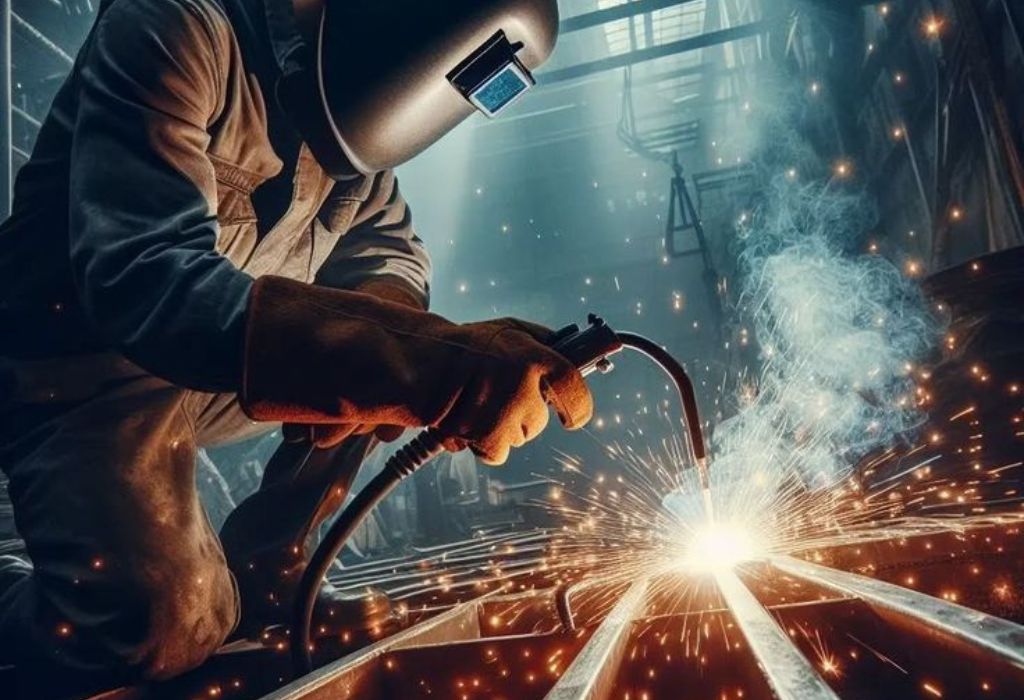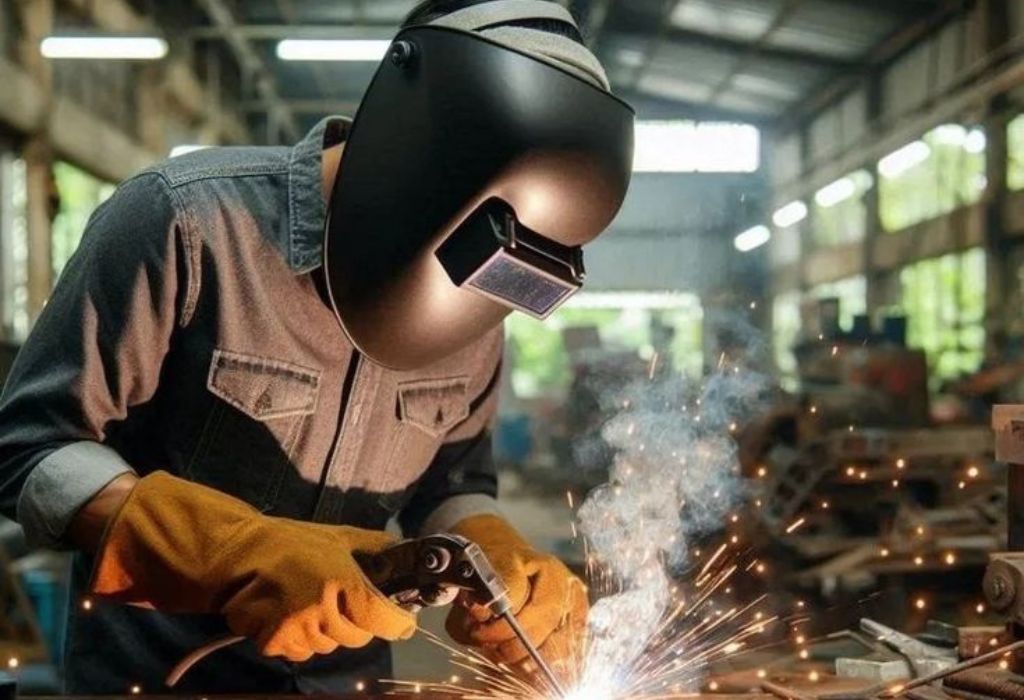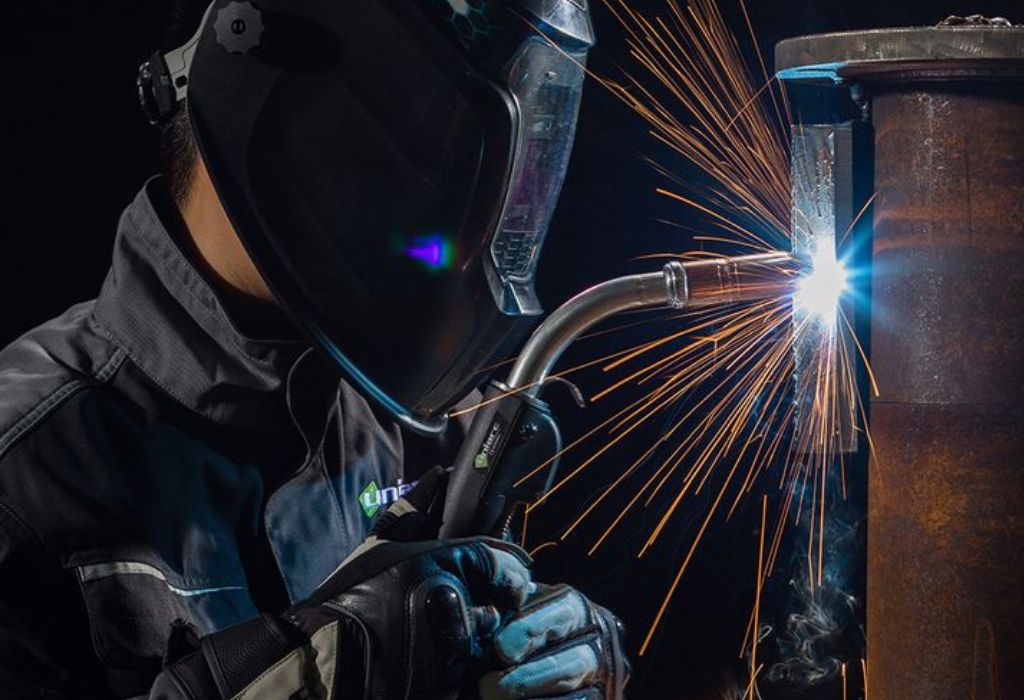The smell of hot metal fills the air as sparks dance across the workshop floor.
A welder lifts his helmet, wipes his brow, and switches machines — from a stick welder for rough repair to a TIG for a clean stainless finish.
Every job demands a different tool, yet many beginners have one question in common: what are the 7 types of welding machines and which one should I choose?
Walk into any welding supply store, and the choices can be overwhelming. MIG, TIG, Stick, Flux-Core, and more — each claims to be the best. The truth is that every welding machine serves a specific purpose depending on metal type, thickness, environment, and finish quality.
According to Grand View Research, the global welding equipment market is projected to exceed $27.8 billion by 2030, driven by industries like construction, shipbuilding, and automotive (Grand View Research).
In this guide, we’ll simplify the confusion. You’ll learn about the 7 main types of welding machines, how each one works, where it’s used, and how to choose the right one for your next project.
The 7 Types of Welding Machines — Quick Overview

Before diving deeper, here’s a simple breakdown of the seven core types used across workshops, factories, and shipyards worldwide:
- Stick (SMAW) – Reliable for outdoor jobs and thick metals.
- MIG (GMAW) – Fast and easy to learn, great for production work.
- TIG (GTAW) – Clean, precise, and perfect for thin stainless or aluminum.
- Flux-Cored (FCAW) – Ideal for windy conditions and heavy fabrication.
- Submerged Arc (SAW) – Industrial-grade, used for long welds on thick plates.
- Resistance/Spot (RSW) – Used for sheet metal and automotive assembly.
- Plasma Arc (PAW) – Advanced process for precision, depth, and speed.
Which welding type is best for beginners?
MIG and Stick welders are easiest to learn and most versatile for beginners.
Which process gives the cleanest welds?
TIG welding produces the smoothest, most attractive welds with minimal cleanup.
Which is fastest for production?
MIG and Submerged Arc welding deliver the highest deposition rates.
Which works best outdoors?
Stick and Flux-Cored machines handle wind and rusted metal better than others.
1. Stick Welding (SMAW) — Simple Power for Tough Jobs
Stick welding, or Shielded Metal Arc Welding (SMAW), is one of the oldest and most reliable methods.
It uses a flux-coated electrode that melts into the joint, while the flux forms a gas shield to protect the molten weld.
This process works exceptionally well on thick metals, dirty surfaces, and outdoor environments.
Farmers, pipeline workers, and construction welders often rely on SMAW for its portability and toughness.
What materials can it weld?
Mostly carbon steel and cast iron, but also stainless with the right rods.
Is it suitable for outdoor work?
Yes. Stick welding doesn’t rely on bottled gas, so wind isn’t a problem.
What skill level does it require?
It’s beginner-friendly but takes practice for smooth bead appearance.
What are its drawbacks?
More spatter, slower deposition, and extra cleanup due to slag formation.
2. MIG Welding (GMAW) — Speed and Simplicity Combined
MIG, or Gas Metal Arc Welding (GMAW), uses a continuously fed wire and a shielding gas to protect the weld.
It’s known for its speed, ease of learning, and clean operation — perfect for beginners and professionals alike.
This process shines in fabrication shops, automotive work, and general manufacturing where productivity matters.
According to Lincoln Electric, MIG welding can deposit metal up to four times faster than stick welding (Lincoln Electric).
What metals can MIG weld?
Steel, stainless, and aluminum (with a spool gun attachment).
Why is MIG popular in workshops?
Because it’s fast, produces neat welds, and requires minimal cleanup.
Is MIG welding easy to learn?
Yes — its “point-and-weld” simplicity makes it ideal for beginners.
What’s the main limitation?
It’s not great outdoors since wind can blow away the shielding gas.
3. TIG Welding (GTAW) — The Cleanest, Most Precise Welds
TIG, or Gas Tungsten Arc Welding (GTAW), delivers unmatched precision and control.
It uses a non-consumable tungsten electrode and a separate filler rod, with argon gas shielding the weld pool.
TIG is the top choice for aerospace, automotive, and high-end fabrication, where clean aesthetics and accuracy matter most.
It’s slower and more skill-intensive but produces welds that require little to no finishing.
Why choose TIG over MIG?
It offers superior control over heat and bead appearance, perfect for thin materials.
Can TIG weld aluminum?
Yes, but it requires AC current and advanced control features.
Is it beginner-friendly?
Not exactly. TIG takes patience and coordination between torch, pedal, and filler.
What’s TIG best used for?
Stainless steel, aluminum, copper, and decorative or precision projects.
4. Flux-Cored Welding (FCAW) — Heavy-Duty and Wind Resistant
Flux-Cored Arc Welding (FCAW) is similar to MIG but uses a tubular wire filled with flux instead of solid wire.
This allows welding without a gas cylinder — a big advantage outdoors or in windy conditions.
It’s widely used in construction, shipbuilding, and heavy equipment repair because it delivers deep penetration and fast welds.
Gas or gasless — what’s the difference?
FCAW-S is self-shielded (no gas), while FCAW-G uses an external shielding gas for cleaner welds.
Where does Flux-Core welding shine?
In environments where wind, dirt, or rust would ruin MIG welds.
Is Flux-Core good for beginners?
Yes. It’s forgiving and works well on thicker materials.
What’s the downside?
It creates more smoke and slag, requiring extra cleanup afterward.
5. Submerged Arc Welding (SAW) — The Industrial Workhorse

Submerged Arc Welding (SAW) operates beneath a layer of granular flux that completely hides the arc from view.
This method allows for very high deposition rates and deep penetration — ideal for heavy plate welding.
You’ll find SAW machines in shipyards, pressure vessel plants, and large-scale steel fabrication facilities.
It’s a semi-automatic or automatic process that demands specialized setups.
Why is the arc “submerged”?
The flux covers the weld, preventing spatter and improving metal quality.
What materials is SAW used on?
Mainly thick carbon steel and structural plate.
Can it be used manually?
No, it’s mostly automated for long, consistent welds.
What’s its main advantage?
Extremely fast production with excellent weld strength and consistency.
6. Resistance/Spot Welding (RSW) — For Sheet Metal Precision
Resistance welding joins metal by pressing and passing current through two sheets until they fuse.
It’s the backbone of automotive manufacturing and appliance production where speed and consistency matter.
Spot welders create strong joints without filler or flux — just heat, pressure, and timing.
Because of its precision, RSW is ideal for thin materials and mass production lines.
Where is resistance welding used most?
In car body panels, battery packs, and sheet-metal enclosures.
Can you use it at home?
Yes, small handheld spot welders exist for light sheet metal.
Is it strong?
Yes, when done correctly — multiple spots can equal or exceed seam strength.
Does it need filler material?
No. The weld is made purely by melting and bonding the base metals.
7. Plasma Arc Welding (PAW) — Speed Meets Precision
Plasma Arc Welding (PAW) is a high-energy process that uses a constricted plasma jet for an extremely focused, hot arc.
It’s often seen as an advanced version of TIG — faster, deeper, and cleaner.
PAW is used in aerospace, medical device manufacturing, and instrumentation where precision is critical.
The process can achieve narrow, deep welds with minimal distortion.
How is plasma welding different from TIG?
Plasma uses a smaller, high-velocity arc that provides better penetration and stability.
Is it good for production work?
Yes, it’s efficient for thin, high-value materials that require accuracy.
Why isn’t plasma welding more common?
Its cost and complexity make it suitable mainly for specialized industries.
Does it require special training?
Yes, it’s typically handled by experienced TIG welders transitioning to high-precision work.
Choosing the Right Welding Machine
Selecting the right machine depends on what you weld, where you weld, and how often you weld.
Each process has strengths tailored to specific materials and situations.
| Purpose | Best Welding Type | Reason |
| Outdoor repair & farm work | Stick or Flux-Core | Handles rust, dirt, and wind |
| Auto body & fabrication | MIG | Fast, clean, easy setup |
| Thin stainless or aluminum | TIG | Precise control & aesthetics |
| Heavy plate welding | SAW | Deep penetration & high speed |
| Sheet metal joining | RSW | Clean, fast, automated |
| Aerospace & precision parts | PAW | Narrow, accurate welds |
Can one machine do everything?
Multi-process welders exist, but each type still has its own sweet spot.
Is 120V or 240V better?
120V suits light-duty welding; 240V handles thicker metals and longer duty cycles.
Do I need gas for all welders?
No — Stick and some Flux-Core welders are self-shielded.
How do I decide as a beginner?
Start with MIG or Stick; they balance cost, ease, and capability.
Welding Safety and Good Practices

Every process comes with risks — burns, UV radiation, and fumes.
Following proper safety protocols is non-negotiable for all welders.
According to CCOHS, exposure to UV rays and fumes is a major hazard, and all welders should use auto-darkening helmets, gloves, jackets, and ventilation (CCOHS).
What PPE is essential?
Helmet (shade 10–14), gloves, leather jacket, boots, and safety glasses.
Do all welding types produce fumes?
Yes. Flux-Core and Stick produce more; TIG and MIG less, but ventilation is always needed.
Is shielding gas dangerous?
Not toxic, but it can displace oxygen — never weld in confined spaces without airflow.
How to stay safe daily?
Keep fire extinguishers nearby, inspect cables, and follow duty-cycle limits to avoid overheating.
Future Trends in Welding Technology
Welding technology is evolving fast.
Today’s welders enjoy lightweight inverter machines, smart controls, and energy-efficient designs.
The global welding market continues to grow, with demand increasing across construction, oil & gas, and manufacturing sectors (Arizton Report).
Are welders becoming cheaper?
Yes, inverter technology is lowering prices while improving performance.
Will automation replace welders?
Not entirely — robots handle repetitive welding, but human skill remains vital for custom fabrication.
What’s the next big innovation?
AI-driven systems that automatically adjust parameters for perfect welds every time.
Are battery-powered welders real?
Yes, portable battery-based units are emerging for field repairs.
Conclusion
So, what are the 7 types of welding machines?
They include Stick, MIG, TIG, Flux-Core, Submerged Arc, Resistance/Spot, and Plasma Arc — each with its unique strengths and best uses.
Stick and Flux-Core handle rugged outdoor jobs.
MIG delivers speed and ease.
TIG and Plasma achieve perfection where precision matters.
SAW powers industrial-scale projects, while RSW excels in automated production.
Understanding how these machines work helps you choose wisely — not just based on price, but on purpose.
Whether you’re welding car panels, ship hulls, or fine stainless art, there’s a perfect tool for every task.
Choose your machine, practice safely, and master the craft that holds the modern world together.

I’m Darrell Julian, the founder, lead writer, and hands-on welding enthusiast behind ArcWeldingPro.com. With more than 15 years of real-world welding experience, I created this platform to share what I’ve learned in the field, in the shop, and in the heat of the arc.


